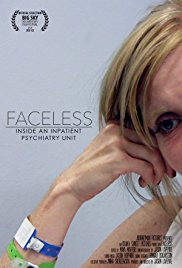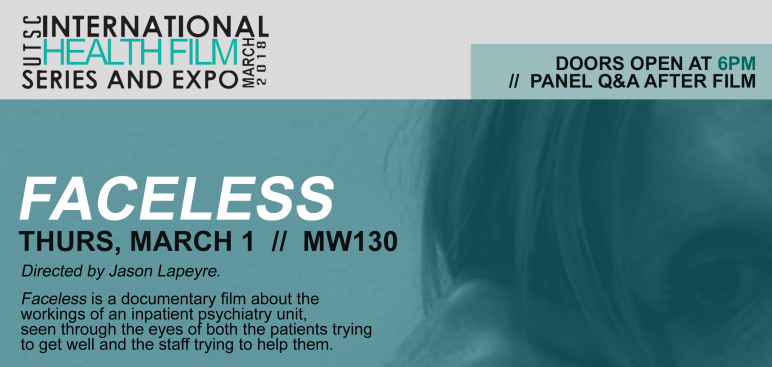Post by HLTD50 student Riya Garcia
 The first film screened at this year’s International Health Film Series & Expo (IHFSE) at UTSC was a great hit. On March 1, 2018, the audience engaged in critical thinking about the multiple issues raised by this Toronto-based documentary. Faceless (2012) illustrates patients’ daily life experiences in an inpatient psychiatric unit, viewed through the lens of both the patients aiming to get well and the staff trying to understand the patients’ perspective of their illness experience.
The first film screened at this year’s International Health Film Series & Expo (IHFSE) at UTSC was a great hit. On March 1, 2018, the audience engaged in critical thinking about the multiple issues raised by this Toronto-based documentary. Faceless (2012) illustrates patients’ daily life experiences in an inpatient psychiatric unit, viewed through the lens of both the patients aiming to get well and the staff trying to understand the patients’ perspective of their illness experience.
Various elements of the film, such as the gaze of the camera, art therapy, and music, formed a well structured illustration of the ongoing issues prevalent in one inpatient psychiatric unit located in downtown Toronto. Some of the key issues were the power dynamics of patients and health care professionals, patients’ typically disempowered position in the health care setting, and the systematized provision of health care.
The discussion following the film included filmmaker and physician Dr Anna Skorzewska, director Jason Lapeyre, and UTSC alumnus and mental health advocate Joshua Miller.
*
Issue 1: The Significance of the Social Determinants of Health (SDoH): Socio-economic Status (SES) and Employment
These two interrelated determinants of health are the root causes of what Dr Skorzewska and Lapeyre described as “the revolving door” of mental health care, where patients get trapped in the system of returning back to the inpatient psychiatric unit instead of recovering back into the community outside of the hospital. Compounding this issue is the problem of the “glass-ceiling,” which describes the patients’ barrier to employment due to the stigma of mental illness in many workplaces. Combined, these factors disempower patients in the culture of psychiatric centers as they get trapped in the mindset–and to some extent, the partial reality– that there is no way out of the institutionalization of mental illness, or that treatment and cure are harder than simply receiving a discharge.
Issue 2: The Outsider vs. Insider Gaze
In the course “Perspectives on Culture, Illness, and Healing” (HLTB42), we have discussed the importance of understanding the practices and meanings of everyday life in terms of language, our bodies, our identities, and social environments. Understanding these factors can influence our sense of empathy and interactions with others.
As I was viewing this film, my gaze kept shifting from an outsider to insider perspective in response to the camera’s gaze. During the scenes where the doctor and patients are directly communicating with each other, I tried to view the patient’s perspective with an insider’s gaze as it was important to understand their subjective illness experience for the doctors to effectively help them. As a third year Health Studies student, I have learned how powerful language can be as it can either help vulnerable individuals to seek out for health care services or fear not to seek out for help due to doctor’s prejudices.
Issue 3: The Doctor-Patient Relationship
This relationship in the health care setting is essential in building trust for the patients to feel safe and for them to effectively comply with treatment plans provided by doctors. Even though power dynamics will always be present in the medical sphere due to politics, Dr Skorzewska suggested that a “symbiotic” relationship between the doctor and patient might turn out to be more therapeutic in the long term as patients feel more empowered and are seen as a whole person in a holistic perspective.
Furthermore, if patients are more actively involved with their treatment regimens, it may create a less chaotic environment as doctor’s can work on building therapeutic relationships with patients and patients can value their autonomous decisions. This shift to a symbiotic relationship can help patients recover efficiently and effectively as it becomes easier for them to make connections across boundaries. Doctors respecting their patient’s belief system is also part of building a strong relationship. For example, I was intrigued when I heard the spiritual counsellor’s comment in the film that 80% of psychiatric patients believe in God and only 20% of psychiatrists believe in God; this difference would probably have a significant impact on the possibility of a multidisciplinary treatment plan provided to a patient.
My Final Thoughts: A Health Humanities Perspective
Understanding the subjectivity of patients’ illness stories may be hard for some health care professionals, as they are used to using objective measures of assessment when diagnosing people. The medicalization of pathology has lead to an increase of labels that may or may not fit certain individuals to a particular category. I believe that strict adherence to objective classifications, for example those listed in the DSM-V, have the potential to create more chaos rather than order, especially in cases of mental illness. It is essential for doctors to have informal conversations over time with their patients to monitor their trajectory of their illness experience as they strive to recover effectively.
The film screening of “Faceless” nicely tied into what I was learning in both of the courses I am taking this semester: HLTD50 (Toronto’s Stories of Health & Illness) and HLTB42 (Perspectives on Culture, Illness, and Healing). This documentary illustrated several elements relevant to the field of interdisciplinary studies of health as well as highlighting key issues relevant to the practice of psychiatric medicine in Toronto.
